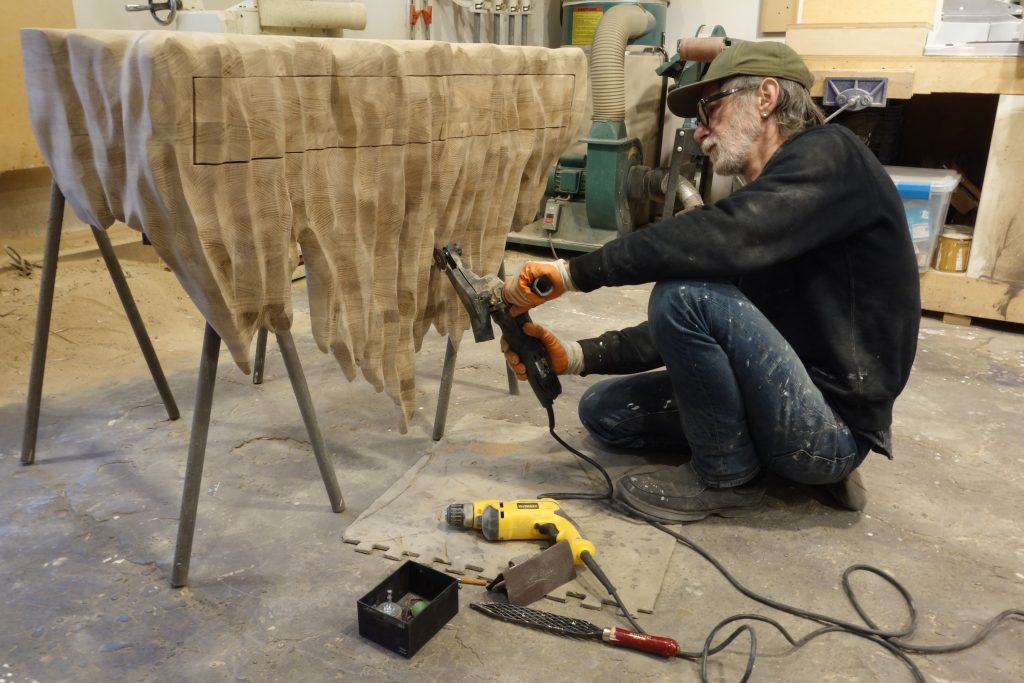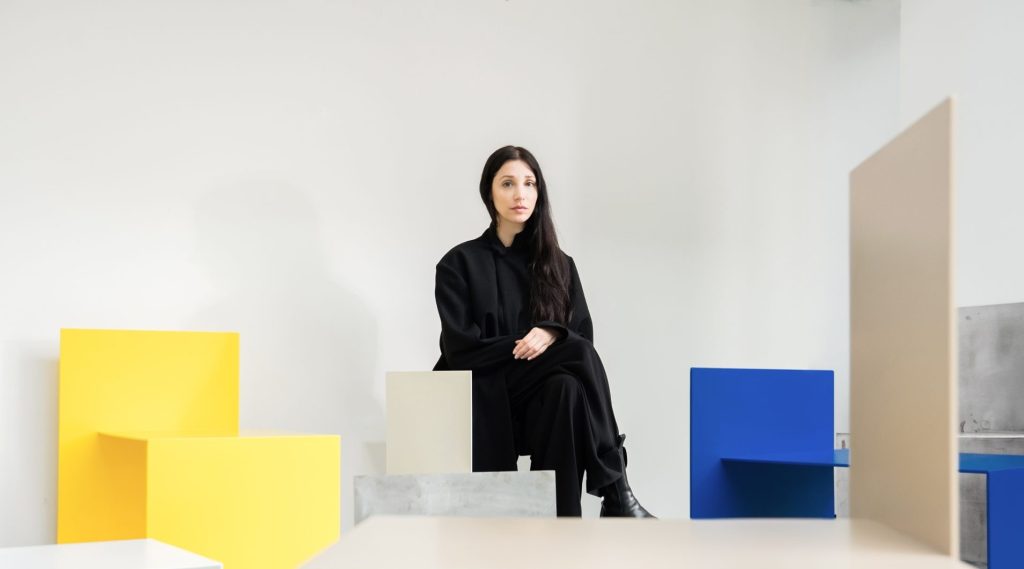Seray Asker: Designing goddesses, beasts & other modern myths
“The thought that I was breathing the same wind as our ancestors did a million years ago … carrying their culture
to the 2000s in a modernized way.”
– Seray Asker
Images of the works courtesy of the artist. Studio photos, credit: Rhctangles.
View Seray Asker’s works, including pieces from the Goddess & Beasts of Cappadocia series.
Minimalism, primitivism and abstraction have been major driving influences and movements affecting contemporary fine art and modern aesthetics over the past century. Hailed as futuristic, edgy or daring these styles and works of art exist as a revolt against the romanticist figurative styles favored by artists of the centuries before, where intimate representations of human figures or heroic landscapes shaped the taste of the ruling classes of the west. Where dramatization played a heavy influence in these stylized hyper-realistic depictions, abstract representation offered artists a new means of compelling audiences. One trailblazer in this era was non-other than Pablo Picasso whose inspiration came mainly from appropriated styles of various African cultures, the west’s fascination and “rediscovering” of these artistic styles is a practice still continued and hailed to this day. From native Alaskan Yupiks masks inspiring Italian artists, such as Ugo Rondinone, or African figuration inspiring the Spanish master, what is it about these forms and formal language that so captived artists of the west?
Beast, heroes, gods, and goddesses are all forms and characters that pop-up in the oral and visual traditions of cultures around the globe, Venus effigies or fertility idols are some of the oldest forms of representational art that still exists today. Across geographically separated lands these stories helped groups of people self-identify and created cultures for complex societies to develop. Millennia later, an image of curved humanoid figures or a beast with seven eyes can still convey its mystic captivation as it has done since it was drawn in ash on a cave wall. For cultures in various regions across the globe this formal language was never lost, yet it took outsiders to bring its significance to an international stage. But how will this change in the future?
Crossing cultures, eras and disciplines, Turkish designer and artist Seray Asker uses her storied experiences to form a language that transcends a modern world of humanity that has lost touch to its mythical beginnings. Originally from Istanbul but now based in Granada, Spain, her journey to develop her artistic practice has taken her to the Netherlands, Sweden and even back to Turkey, in Cappadocia. Holding degrees in Swedish and Spanish philology, Asker has undergone deep investigations not only into our material world and the imagery involved in mythmaking, but also in our narrative development of oral language. Applying her understandings of the wisdom of the past and her own cultural story, Asker pays homage in a series of ceramic works to goddesses, beasts, and how these ideas of mythical proportions can lend some guidance in an era of rapid technological obsession.


What are the main sources of inspiration for your imagery and iconography in your works?
Although we are living in an era of technology, I am utterly fascinated by primitive art and historical findings. In this chapter of my art journey (which I think is truly one of the most inspiring and edifying chapters) I am drawn towards these crude representations. This is the main source of my inspiration.
Historical pieces of art give a feeling of simplicity and refinement. In addition to this, they hold very strong energy of the period and site they come from which is quite magical for me. Since they belong to a world which was not complicated by technological mess, the naivety is felt strongly as you look at them. I try to let myself flow and try to feel the same as the creators of primitive art might have felt when they were creating their pieces. To explain it: I don’t attach importance to perfectionism. I try to create as simply as possible without being carried away by the unnecessary details. And as long as I can, I also make my own tools. This varies from making traditional handmade brushes from straws instead of high-end paintbrushes to apply the paint, to composing my own mixtures for ceramic dyes. I attended courses and did huge amounts of research into mixing my own engobes, slips, and glazes using raw materials from nature. All of which at the end become artistic details of unique handmade design.


Apart from being visually beautiful, your works contain a rich cultural story. How do audiences react to this duality of your work? How fully do they engage with the deeper meaning?
I can say that there are two kinds of audiences. The first being people that are not so into history and culture. They have such an untouched way of interpreting my works based on their own world and experiences. I am thrilled with the comments and interpretations from this kind of audience. Original points of view come up since they are not influenced by the real source of my works. But they get really excited. After so many interactions with this type of audience, I am sure that their excitement comes from subconscious roots that are responding to my designs.
The second kind of audience, the one that has a lot of interest and knowledge of history, art history and culture. They are mesmerized by seeing the old iconography in a modernized way. There is a lot of respect and appreciation too which is one of the biggest motivations for me to continue more with this concept.
The roots mean a lot. Moreover, in this artificial era that we are in, everyone is subconsciously searching for their roots in everything.
You have quite an extensive history in traveling and living abroad, how has this shaped your connection towards your own culture?
I want to savor as much of this planet as possible until my journey in this life is over.
Regarding my connection towards my own culture, this journey of traveling and living abroad helped me to see my roots and my culture from the outside. You know that feeling of being absorbed by something so much that you can not say how it looks because you are already inside? Now that I have been away for a long time, I see it from a different perspective and I appreciate and relish it more and more every day. Maybe I am getting more mature and noticing the treasure that my land holds.
My journey back to my motherland finalized in Cappadocia, a hermetic, magical land that became the center of my inspirational journey for my primitive art series. It was such a marvel knowing that the historical art pieces that I have been watching in the museums and excavation sites, which gave me goosebumps were made of the very soil and dust that I was walking on. I was reading books about the ancient civilizations and at the same time listening to the stories from the archeologists, guides, locals about the land. Along with the factual history, I was abundantly rewarded with a pleasing inspirational cocktail of myths, legends and fiction told by natives.
To restore and rejuvenate, to pause the isolation-creation periods in my studio, I was taking long walks to feel the energy of that magical place. The thought that I was breathing the same wind as our ancestors did a million years ago, made me feel like I was again a part of that big piece, to crown it all as an extension to the future, carrying their culture to the 2000s in a modernized way.



Many similar ideas when it comes to form and figurative representation from culturally traditional art forms (minimalism and abstraction) are now re-appreciated in contemporary and modern art throughout the world, especially in the west. What does this re-appreciation mean to you in your work, what particular sentiments from this do you want to utilize in your work?
People re-appreciate it because they feel the naivety of it and naivety is something that penetrates the soul.
My love for mixing various art movements in my previous works is quite notable. I am a fan of the eclectic approach and the traditional art forms always make a good dance partner to futuristic movements. The connection between the old and the new is simply amazing.
I would like to continue utilizing the infinite source of history for concepts of the new series. There already is a huge collection of old imagery that I’ve gathered and there are new findings that add up every day. They are waiting to be reborn and I am overly excited about losing myself in the new series.


In what ways do you think a stronger connection to iconography and ideas such as goddesses, mythology, and myth-making would benefit us in the modern era?
They surely would add some fairy dust to our imagination and also help us to see that the old civilizations were more civilized compared to us in many ways. It is kind of tragicomic but true.
The mystery of the myths and the inexplicable creations are great triggers to make us question our existence and go deep. And at the same time to question our values too.
For example, talking about the goddesses, I have one series that I created during my excursions in Cappadocia. It is a reference to the matriarchal times where women were the pillars of the community. The new world is full of hope for equality of all sexes yet we, unfortunately, see that there still are many uncivilized parts of us that seem to be taking some time to cure. I hope my Goddess series will be one of the details that help us to remember the strong and maternal energy of the feminine figure that rocked the ancient civilizations. And we can finally carry it us to re-civilization.






To stay up to date on the release of collections, interviews and news on global contemporary design, sign up to our newsletter below.
Bio


Multidisciplinary artist Seray Asker was born in 1978 in Istanbul. She has been living in Spain since 2015. In 2004, she graduated from University, Department of Interior Architecture. She continued her education at another university where she specialized in sculpture. After completing her studies in the Netherlands, she lived in Sweden for 10 years. During this period, she worked as an Interior Architect and Art Consultant in the design sector and her works created in various disciplines of visual arts took part in many personal and group exhibitions in various countries. At the same time, she studied Swedish Philology as her second interest: languages. In addition to working as an art consultant in Spain, to where she moved to complete her education in Spanish philology 4 years ago, she has been working on ceramics for the last 2 years. The visual arts disciplines she lately applies include fiber art, painting, sculpture and ceramics.









